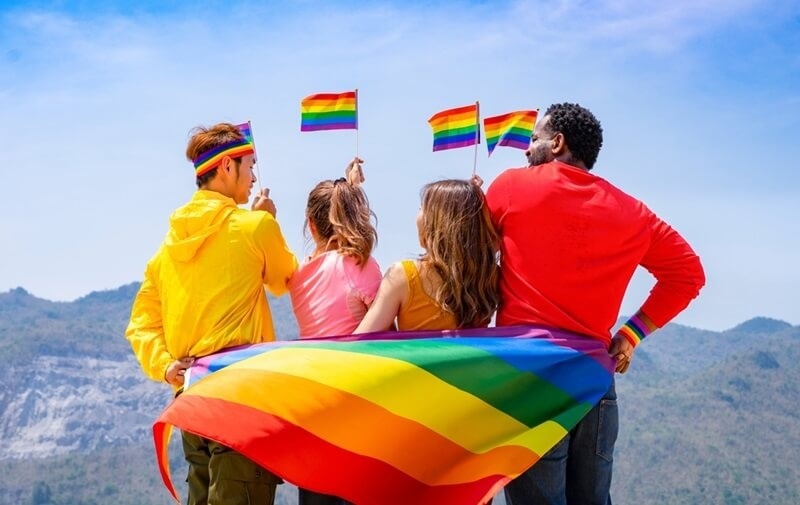Decoding the Symbolism Behind the Straight Pride Flag

Image: Etsy
The "Straight Pride" flag, often a symbol of controversy, represents heterosexuality and is used by some as a counter to the LGBTQ+ pride flags. The concept emerges from a broader discourse on sexual identity and the public's expression of pride in their personal identity. Unlike the universally recognized rainbow flag symbolizing LGBTQ+ pride, the Straight Pride flag does not have a singular, widely accepted design and instead comes in various forms and motifs.
Development and Variations of the Straight Pride Flag
Initial Designs Inspired by the Rainbow Flag
The initial iterations of the Straight Pride flag drew direct inspiration from the rainbow flag, a symbol of LGBTQ+ pride. One of the earliest designs featured black, grey, and white stripes. This monochrome palette was selected to contrast the vibrant colors of the rainbow flag, symbolically representing the spectrum of gender and sexual identities in a more subdued tone. These colors were intended to reflect a straightforward representation of heterosexuality, avoiding the flamboyance often associated with LGBTQ+ pride events.
The Russian Straight Pride Flag
In a notable development in 2015, the Russian political party United Russia introduced a new variant of the Straight Pride flag. This was during the celebration of the Peter and Fevronia Day, a day symbolizing family values and heterosexual love. The flag depicted a heterosexual family unit a man, a woman, and three children, underlined by the hashtag #RealFamily. It was released in three colors, each representing a different color of the Russian national flag: white, blue, and red.
This design aimed to affirm traditional family structures, often touted by conservative factions as the bedrock of societal values. Also, it highlights the significance of the Pride Flag in promoting traditional values as perceived by certain societal segments.
The "Super Straight" Movement
A more recent and controversial adaptation emerged through the "Super Straight" movement, which began as a social media trend in 2021. Originating on TikTok and quickly spreading across platforms like Reddit and 4chan, this movement was characterized by its declaration of a new sexual orientation "super straight," referring to individuals who do not wish to date transgender people, claiming a distinct sexual identity. The associated flag for this movement features black and orange stripes, reportedly designed to mimic the logo of the adult website PornHub, which was a deliberate choice to provoke discussion and controversy. This flag also occasionally includes symbols like the male and female icons intertwined, further emphasizing the heterosexual aspect of the identity.
These variations of the Straight Pride flag reflect a complex interplay between cultural symbolism and social politics. Each design not only stands as a statement in the ongoing debates about sexual identity and rights but also sparks discussions about inclusivity, tolerance, and the nature of pride movements. The emergence of these flags underscores the tensions within societal norms and the evolving dialogue around what constitutes identity and acceptance in the modern world.
Symbolic Significance
The Straight Pride flag carries varied meanings and implications, deeply influenced by its design and the context of its usage. These flags are not just symbols of heterosexuality but often serve as political statements, reflecting broader social implications. Each variant of the Straight Pride flag, from the monochromatic to the family-centric Russian design, and the provocative "Super Straight" banner, represents different facets of the same underlying desire to assert heterosexual identity as part of a cultural dialogue dominated by discussions about LGBTQ+ rights. In contrast, the Omnisexual Pride Flag serves to inclusively represent omnisexual identities, celebrating a broader spectrum of attractions within the LGBTQ+ community.
The public and media reactions to these flags have been mixed and often heated. Critics argue that the flags, particularly the "Super Straight" version, border on transphobia by explicitly excluding transgender individuals and using symbolism that mimics that of adult content platforms, which could be seen as trivializing the issue. Additionally, some iterations of the Super Straight flag have been linked to extremist symbols, particularly those used by supporters who associate it with Nazi imagery. These associations have sparked fierce debates about the intention and impact of the flags, questioning whether they foster hate under the guise of promoting straight pride.
Global Impact and Reactions
One of the most significant events involving the Straight Pride flag was the Straight Pride Parade held in Boston in 2019. Organized by the group Super Happy Fun America, the event purported to advocate for the rights of the straight community, mirroring the structure and form of LGBTQ+ pride parades. However, it drew extensive criticism and resulted in large counter-protests, with critics arguing that it was a perversion of the pride parade concept, intended to mock and undermine LGBTQ+ rights rather than to celebrate heterosexuality genuinely.
The event and its use of the Straight Pride flag highlighted deep societal divisions, with some viewing it as a necessary balance in a culture they perceive as overly focused on LGBTQ+ issues, while others saw it as an inflammatory and unnecessary display of intolerance. The parade and the flag used during the event became focal points for discussions on free speech, the meaning of pride, and the limits of protest.
You may also like: Unveiling the Power and Significance of the Various Pride Flags
Conclusion
The role of the Straight Pride flag in modern socio-political landscapes is complex and contentious. On one hand, it represents a group's right to express pride in their sexual identity; on the other, it is seen as a reaction to the gains of the LGBTQ+ community, potentially sowing division and promoting exclusion. These flags, regardless of their specific designs, challenge the existing norms and dialogues surrounding sexual identity and pride movements.
The ongoing debates around the Straight Pride flag and its variations reflect broader societal struggles with identity and representation. As the world becomes more accepting of diverse sexual and gender identities, the reactions to and significance of these flags serve as a barometer of cultural tolerance and the evolving understanding of what it means to express pride in one's identity. These discussions are not merely about the flags but the values and beliefs that they represent in the ever-changing landscape of social justice and rights advocacy.
This content was created by AI























